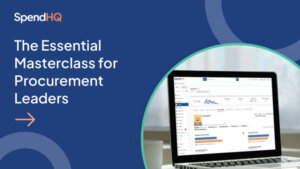Recent years have flooded Procurement with new acronyms, job titles, and initiatives. A lot has changed, but the importance of the category management process—at the heart of best-in-class Procurement—hasn’t.
In many ways, it’s become even more critical. Without putting a thorough category management process in place, teams struggle to enrich their supply chains, wrangle scope 3 emissions, or place spend under management. Putting a thorough system in place is easier said than done. So to help you get started, let’s look at what category management is and how the experts approach it.
What is category management?
Category management is one of the pillars of strategic Procurement. It revolves around breaking purchases down into categories and subcategories and then managing them individually. Usually, this relies on category managers who set and oversee category strategies consisting of supply chain management, spend optimization, and strategic initiatives.
Category management is a simple concept, but it can quickly become complex. For example, many procurement teams handle multiple categories. These organizations consist of managers who oversee individual categories and work with other category teams. Their individual successes are important because they add up to create Procurement’s overall impact. So here’s how the most successful organizations maintain programs that produce results.
Start with the right spend taxonomy
Because Procurement’s success is the sum of each category manager’s wins, the most effective teams start by understanding organizational spend. To many procurement professionals, this means focusing on spend analysis, but there’s another step that must come first—accurate spend taxonomy.
Spend taxonomy is a system that divides spend into categories and subcategories based on purchase types. It’s the backbone of category management, but it’s also the step where procurement teams are most likely to introduce confusion.
Many platforms that help teams attain spend visibility have unique taxonomies. Unfortunately, most are built off a data background, not a procurement background. As a result, they’re useful for organizing spend but not for managing it from a category perspective. For example, some spend analytics platforms use a Dunn and Bradstreet taxonomy that’s based on SIC and NAICS codes. Others use UNSPSC codes.
There are several problems with these classification models, but at core they’re too broad. Even more importantly, they’re not designed for indirect purchasing so they group unrelated expenses together and split related expenses. Starting category management this way is like teeing off with a putting iron. You’re using a great tool in the wrong context, so even if you hit the ball well, it’s not going to go very far.
In contrast, the most effective organizations start with a Procurement-focused taxonomy like the one we built our spend analytics solution Spend Intelligence on. Our taxonomy is based on 20+ years of Procurement consulting experience and over $8 trillion of analyzed spend, positioning teams to move forward with a classification system they can actually do something with.
Make everything visible to stakeholders
Once you have the right taxonomy, it’s time to set your strategy. The most successful businesses align around and execute on central goals. If you follow suit and align with key stakeholders early in your category management process, you can base your category strategy on shared initiatives. Then you simply need to communicate these goals to your team and set them loose.
But if you really want to align and conquer like a pro, you need a way to make progress visible to everyone. Many teams try to use shared spreadsheets, but they create too many issues.
Instead, best-in-class teams find that the best results come from a global, centralized project management tool like our Procurement Performance Management (PPM), which we built to improve Procurement communication and project tracking. By making Procurement’s efforts and results visible to stakeholders at a glance, PPM helps teams cultivate the trust and alignment that they need to work toward real EBITDA improvements.
Work with other category managers
As we’ve established, each category’s performance adds up to define Procurement’s overall success. The best procurement organizations don’t just have tools that facilitate transparency and communication. Their days revolve around using them to consult each other about supplier relationships, contract history, and project statuses so their work is always complementary.
This level of interconnectedness won’t come from project or spend visibility alone. It will also take trust—trust that everyone has the tools they need and are all working toward a common goal. By choosing solutions that break down silos and give teams shared access to projects, contracts, spend analytics, and realized savings, you can set the foundation for a culture of joint success.
Kaizen – the ultimate category management process philosophy
The final piece of a best-in-class category management process is continuous improvement. You should never stop working on a category or your category management process. In fact, you should take a page from Masaaki Imai’s book(literally) and take a kaizen approach.
At its core, kaizen is a simple concept: everyone involved in a process is responsible for making small improvements every day. These small improvements don’t just maintain progress, they push it forward and create amazing results. If you combine this approach with a collaborative solution, your team’s strategic impact will grow.
Conclusion
The best procurement functions in the world share a few things in common: they establish strong communication, they organize and act on data, they make it easy to track progress, provide transparency across the business and they remember that categories are parts of the larger procurement function. In short, the best procurement teams align around visibility and common goals.
There are two simple reasons that they can do this—they understand what it takes to turn strategic vision into action and they’re digitally positioned to act on it. And now you can be too. Our Strategic Procurement Platform combines Spend Intelligence and Procurement Performance Management for this purpose.
Are you ready to see what you can accomplish when you have spend analytics and performance management in one platform? Click below to schedule a demo and discover the possibilities.


